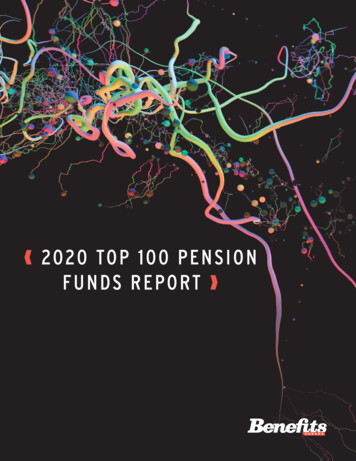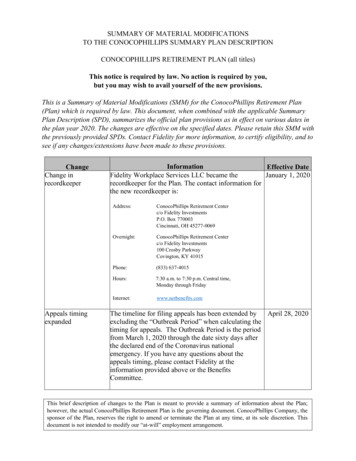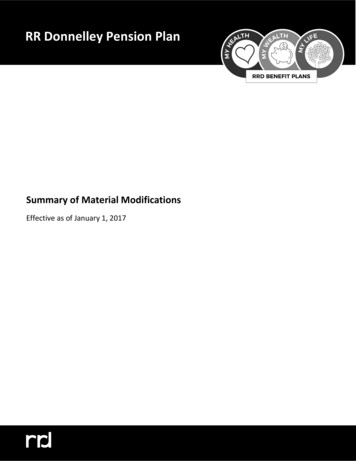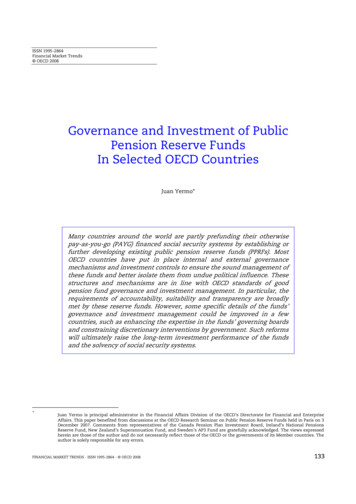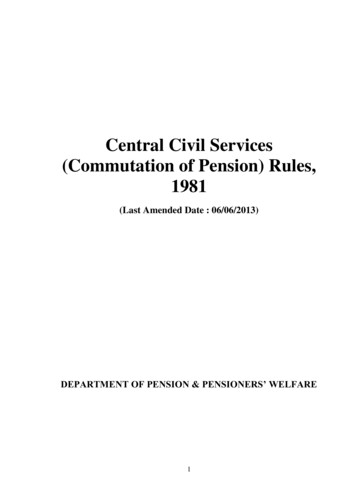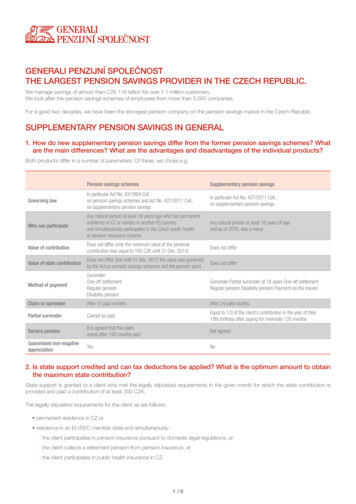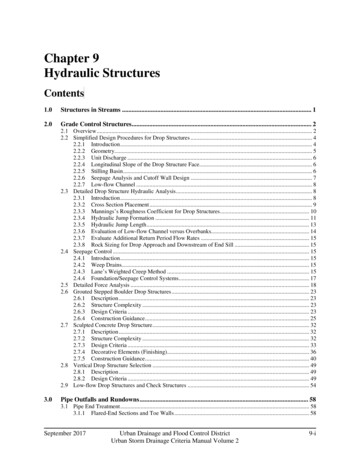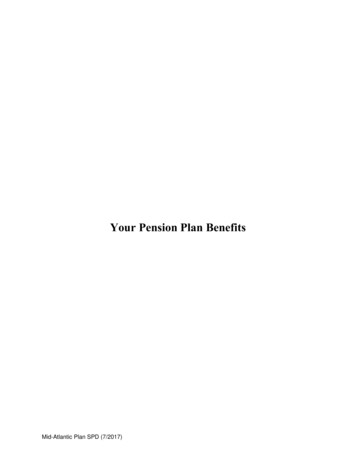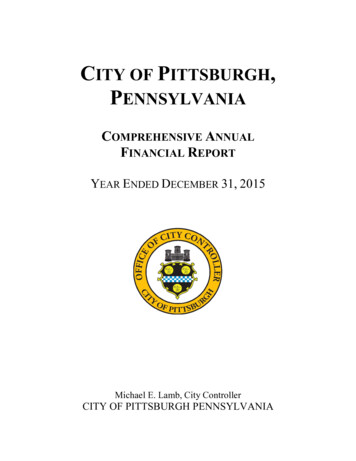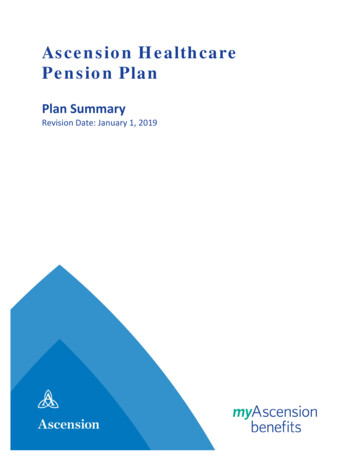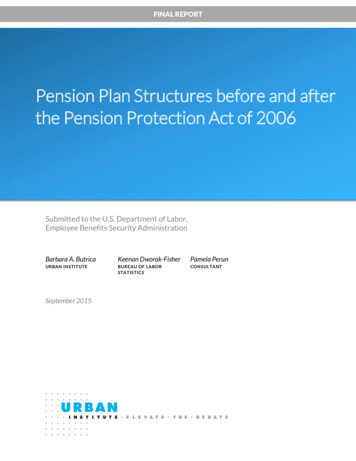
Transcription
FINAL REPORTPension Plan Structures before and afterthe Pension Protection Act of 2006Submitted to the U.S. Department of Labor,Employee Benefits Security AdministrationBarbara A. ButricaKeenan Dworak-FisherPamela PerunURBAN INSTITUTEBUREAU OF LABORSTATISTICSCONSULTANTSeptember 2015
ABOUT THE URBAN INSTITUTEThe nonprofit Urban Institute is dedicated to elevating the debate on social and economic policy. For nearly fivedecades, Urban scholars have conducted research and offered evidence-based solutions that improve lives andstrengthen communities across a rapidly urbanizing world. Their objective research helps expand opportunities forall, reduce hardship among the most vulnerable, and strengthen the effectiveness of the public sector.The Urban Institute is a nonprofit policy research organization. It has been incorporated and is operated as a publiccharity. It has received official IRS recognition of its tax-exempt status under sections 501(c)(3) and 509(a)(2) of theInternal Revenue Code. The Institute’s federal ID number is 52-0880375. Donations will be tax deductible and maybe disclosed to the IRS and the public, unless given anonymously. We are committed to transparent accounting ofthe resources we receive. In addition to required tax filings, a copy of the Urban Institute’s audited financialstatement is available to anyone who requests it.Copyright September 2015. Urban Institute. Permission is granted for reproduction of this file, with attribution tothe Urban Institute.
tive SummaryviIntroduction10Background10The Pension Protection Act of 2006 (PPA)13Automatic Enrollment after the PPA15Data15Analytical Framework19Results21Changes in 401(k) Plan Provisions over Time21Changes in Establishment Costs over Time26Regressions of Change over Time26Changes in Plan Provisions over Time by State Pay Laws27Changes in Establishment Costs over Time by State Pay Laws29Difference-in-Difference Regressions29Discussion31References33Figures and Tables35About the Authors72
AcknowledgmentsThis report was funded by the U.S. Department of Labor, Employee Benefits Security Administration.Urban strives for the highest standards of integrity and quality in its research, analyses, and policyrecommendations. Urban scholars believe that independence, rigor, and transparency are essential toupholding those standards. Funders do not determine research findings or influence scholars’conclusions. As an organization, the Urban Institute does not take positions on issues. Urban scholarsand experts are independent and empowered to share their evidence-based views andrecommendations shaped by research.The views expressed here are those of the authors and do not necessarily reflect the views and/orpolicies of the Bureau of Labor Statistics, or any other agency of the U.S. Department of Labor. Theyshould not be attributed to the Urban Institute, its trustees, or its funders. We thank Nadia Karamchevaof the Congressional Budget Office for proposing this research topic, John Bishow of the Bureau ofLabor Statistics for helping to put together the data, Gary Engelhardt of Syracuse University forproviding us with data on state payment withholding laws, and Richard Johnson of the Urban Institutefor helpful comments.IVACKNOWLEDGMENTS
AbstractThe Pension Protection Act of 2006 (PPA) included provisions designed to enhance definedcontribution plans—such as new protections for automatic enrollment and less stringentnondiscrimination safe harbor rules. This study analyzes the extent to which pension plan structureschanged after the PPA. Our results show that autoenrollment rates, employer maximum contributionrates, default contribution rates, and the likelihood of meeting the safe harbor requirements allincreased after the PPA. Difference-in-difference regressions suggest that the PPA did not directlyaffect autoenrollment, but did reduce default contribution rates and the chances of employers meetingthe new safe harbor requirements.ABSTRACTV
Executive SummaryThe Pension Protection Act of 2006 (PPA) is the most recent comprehensive reform of the nation’sprivate pension law system. Although the main driver of the PPA was to strengthen traditional definedbenefit (DB) plans through enhanced funding rules, it also included provisions designed to enhance cashbalance and defined contribution (DC) plans.This study analyzes the extent to which DC pension plan structures changed after the PPA. Tworelevant goals of the PPA were to increase the number of employees saving in DC plans and to increasethe amount of their DC savings. The PPA included two primary initiatives designed to accomplish thesegoals—new provisions promoting automatic enrollment of employees in DC plans and an additional safeharbor rule providing relief from nondiscrimination testing requirements. In addition to the aggregateeffects of the reform, we examine differences between employers that took advantage of the new plandesign opportunities afforded by the PPA and those that did not, including differences in size, industry,geographic location, unionization, ratio of part-time to full-time employees, and compensation costs.Our study uses restricted microdata from the National Compensation Survey (NCS) conducted bythe U.S. Bureau of Labor Statistics (BLS). The NCS is a large nationally representative survey thatcollects information from establishments on occupational earnings, the incidence and costs ofemployer-sponsored benefits among workers, and the provisions of employer-sponsored benefit plans.Our pre-PPA data come from 2002 and 2003 and our post-PPA data come from 2012 and 2013. In ouranalysis, we refer to these data points as 2002 and 2012, respectively. The key findings are: The share of workers offered and participating in DC plans remained fairly constant between 2002and 2012—with about 65 percent of private-sector employees offered DC plans and about 45percent participating in their employers’ plans. Although the types of DC plans offered changed somewhat over time, the share of workers offered401(k) plans, the most common DC plan, increased only slightly from 65.9 percent in 2002 to 68.6percent in 2012.The remaining analyses focus exclusively on establishments with 401(k) plans. The descriptive analysesare weighted to describe workers with 401(k) plans. The multivariate analyses are unweighted anddescribe plan characteristics and establishment costs. Among workers with 401(k) plans, the share with an autoenrollment feature increased more than 8times between 2002 and 2012 (from 3.9 to 32.3 percent). Although autoenrollment rates increasedVIEXECUTIVE SUMMARY
for all workers in our sample, they increased as much as 22 times for the most advantaged workers(i.e., those in the financial, insurance & real estate industries, those whose employers provided bothDC and DB plans, full-time workers, union workers, and high-wage workers). The employer maximum contribution rate—the percentage of salary the employer contributes if theworker contributes at the match ceiling—averaged 3.45 percent in 2002. It was highest for the mostadvantaged workers. Between 2002 and 2012, however, employer maximum contribution ratesincreased the most for the least advantaged workers (i.e., those in retail trade, those whoseemployers provided only DC plans, part-time workers, non-union workers, and low-wage workers.As a result, the average employer maximum contribution rate was 4.14 percent in 2012 and highestfor the least advantaged workers. Average employer maximum contribution rates in 2002 were also higher for workers in planswithout autoenrollment. Between 2002 and 2012, however, these increased the most for theworkers in plans with autoenrollment. As a result, average employer maximum contribution rates in2012 were higher for workers in plans with autoenrollment than for workers in plans withoutautoenrollment. For example, employer maximum contribution rates increased 18 percent (from3.46 to 4.10 percent) for workers without autoenrollment and 38 percent (from 3.06 to 4.22percent) for workers with autoenrollment. Among workers with autoenrollment plans, the average employee default contribution rate alsoincreased between 2002 and 2012, but only 8 percent from 2.88 percent in 2002 to 3.10 percent in2012. As a result, the average employer default contribution rate—the maximum employer’scontribution at the employee default contribution rate—increased only 26 percent from 1.96percent in 2002 to 2.46 percent in 2012. Consequently, the share of workers in autoenrollment plans with employer maximum contributionrates of more than 3 percent increased from 29.8 percent in 2002 to 63.6 percent in 2012.However, the share with employer default contribution rates of more than 3 percent declined from15.3 to only 12.2 percent over the same time period. Given the rise in autoenrollment, the increased generosity of employer maximum contributionrates, and the increased generosity of employer default contribution rates, it’s not surprising thatthe share of workers in plans meeting the safe harbor requirements increased between 2002 and2012. For example, only 37.7 percent of workers in 2002 were in plans that met the old safe harborrequirement of an employer maximum contribution rate of at least 4 percent, compared with 60percent of workers in 2012.EXECUTIVE SUMMARYVII
Less than 1 percent of workers in 2002 were in plans that met three of the new safe harborrequirements of an employer maximum contribution rate of at least 3.5 percent, autoenrollment,and an employer default contribution rate of at least 3 percent. By 2012, the share of workersincreased to 14.6 percent. While the increase between 2002 and 2012 is dramatic, our resultssuggest that even after the PPA, a relatively small proportion of workers were in plans meeting thesafe harbor requirements. In fact, only 5.5 percent of workers in 2012 were in plans meeting all fournew safe harbor requirements of an employer maximum contribution rate of at least 3.5 percent,autoenrollment, an employee default contribution rate of at least 3 percent, and an employeemaximum default contribution rate of at least 6 percent. Controlling for time, establishment, job, and plan characteristics, we find similar results as thedescriptive statistics. That is, autoenrollment rates increased and plan take-up rates declined afterthe PPA. At the same time, employer maximum contribution rates, default contribution rates, andthe likelihood of meeting the safe harbor requirements increased. However, when we use difference-in-difference regression analysis to measure the causal effect ofthe PPA on automatic enrollment and plan take-up, we are unable to find a significant effect. We dofind, however, that the PPA is associated with lower default contribution rates and a lowerlikelihood that employers meet the new safe harbor requirements.Because the employee default contribution rate is significantly lower than the match ceiling inmany 401(K) plans that automatically enroll employees, participants defaulting into plans cannot takefull advantage of the employer match unless they opt to contribute more. However, studies consistentlyfind that employees tend to remain at the defaults. By boosting plan participation, automatic enrollmentlikely increases employer costs as previously unenrolled workers receive matching retirement plancontributions. Knowing that most employees remain at the defaults, employers might respond to thesurge in retirement plan costs associated with automatic enrollment by setting low employee defaultcontribution rates.An important limitation of our study is that the difference-in-difference approach focuses solely onthe PPA provisions that supersede state payroll withholding laws. Although we find no evidence thatthe PPA triggered higher autoenrollment and take-up rates by superseding state payroll withholdinglaws, its effects through other avenues (such as the establishment of Qualified Default InvestmentAlternatives and Qualified Automatic Contribution Arrangements) may be significant.Demographic trends and impending reforms suggest that Social Security will likely replace a smallershare of pre-retirement earnings than it does today, increasing the importance of employer-sponsoredVIIIEXECUTIVE SUMMARY
retirement plans in providing adequate income. Evidence of the effect of the PPA on employer behaviorprovides valuable lessons for future policy reforms. Our findings have long-term implications for theretirement security of Americans. Although most 401(k) plans now have an autoescalation feature, ourresults suggest that even at the end of the autoescalation process, employee default contribution ratesare significantly lower than what employees would need to contribute to obtain the maximum employermatch possible. Thus, possible reforms should consider instituting minimum employee defaultcontribution rates or increasing the minimum necessary to meet safe harbor requirements.EXECUTIVE SUMMARYIX
IntroductionThe Pension Protection Act of 2006 (PPA) is the most recent comprehensive reform of the nation’sprivate pension law system. Although the main driver of the PPA was to strengthen traditional definedbenefit (DB) plans through enhanced funding rules, it also included provisions designed to enhance cashbalance and defined contribution (DC) plans.This study analyzes the extent to which DC pension plan structures changed after the PPA. Tworelevant goals of the PPA were to increase the number of employees saving in DC plans and to increasethe amount of their DC savings. The PPA included two primary initiatives designed to accomplish thesegoals—new provisions promoting automatic enrollment of employees in DC plans and an additional safeharbor rule providing relief from nondiscrimination testing requirements. In addition to the aggregateeffects of the reform, we examine differences between employers that took advantage of the new plandesign opportunities afforded by the PPA and those that did not, including differences in size, industry,geographic location, unionization, ratio of part-time to full-time employees, and compensation costs.While previous work has explored in detail the determinants of employees’ willingness toparticipate and save in employer-sponsored retirement plans, the literature on the employers’ role isrelatively limited. In addition, few known studies have specifically considered the effect of the PPA onemployer behavior. Two exceptions found significant impacts of the automatic enrollment anddiversification provisions in the PPA on firm behavior (Engelhardt 2011).Given that the majority of retirement saving outside of Social Security happens in the workplace,employer decisions about whether to sponsor a plan, which type of plan to offer, and the specificprovisions of the plan play an important role in workers’ ultimate saving outcomes. Evidence of theeffect of the PPA on employer behavior will provide valuable lessons for future policy reforms.BackgroundThe pension landscape in the United States has been gradually shifting as employers move away fromoffering their employees DB pension plans towards offering them DC plans. Between 1989 and 2014,the proportion of private-sector full-time workers participating in DB pension plans declined from 42 to19 percent, while the share participating in DC plans increased from 40 to 52 percent (Wiatrowski2011; Bureau of Labor Statistics 2014).10PENSION PLAN STRUCTURES BEFORE AND AFTER THE PENSION PROTECTION ACT OF 2006
The rise in DC plans has introduced problems not typically experienced with DB pensions. In DBpensions, employees automatically become eligible to participate and to accrue benefits under rules setforth in the plan. Private-sector employers typically fund the entire cost of the plan. In DC plans,employees are provided with their own retirement savings accounts into which they may or may not bepermitted to contribute. In addition, employers may or may not contribute to these accounts. Unlike DBplans that promise employees a fixed stream of retirement income based on salary and service years,the value of retirement savings accounts depend on how much is contributed and how well investmentsperform over time. Thus, DC plans do not guarantee future retirement benefits.In the type of DC plan known as a money purchase plan, employers commit to a fixed contributionevery year. In the type of DC plan known as a profit-sharing plan, employers choose whether they willmake a contribution each year. If the profit-sharing plan has a “401(k)” feature, employees can elect tomake pre-tax contributions to their accounts. 1 Employers also frequently provide a matchingcontribution to the accounts of employees who contribute to their own accounts. In addition, employerscan deduct from their federal income taxes any contributions they make to employee retirementaccounts.In 401(k) savings plans, employees must decide whether or not to contribute and, historically, manyemployees offered 401(k)-plan coverage have chosen, actively or passively, not to participate. As aresult, participation rates among private wage and salary workers in 2014 who were offered anemployer retirement plan were 86 percent in DB pensions but only 70 percent in DC plans (Bureau ofLabor Statistics 2014). Even among full-time workers—whose participation rates are typically higher—participation rates were 88 percent in DB pensions but only 74 percent in DC plans (Bureau of LaborStatistics 2014).Despite the popularity of 401(k) saving plans among employers, participation by employees hasbeen a persistent concern of policymakers. For decades, large numbers of employees have failed to takeadvantage of the ability to save for retirement offered by these plans. Not only are these workers nottaking advantage of tax-deferred opportunities to save for retirement, but many are forfeiting moneyby not taking advantage of their employer’s matching contributions. Karamcheva and Sanzenbacher(2010) use the Survey of Income and Program Participation to explore some of the reasons whyworkers do not participate in their employers’ defined contribution plans. Some typical reasons givenare “not eligible,” “cannot afford to contribute,” “do not want to tie up money,” and other reasons such1Money purchase plans in the Bureau of Labor Statistics’ National Compensation Survey can also have a 401(k)feature.PENSION PLAN STRUCTURES BEFORE AND AFTER THE PENSION PROTECTION ACT OF 200611
as “too complicated,” and “don’t know how to invest.” Other research shows that procrastination andinertia play an important role in workers’ savings choices and that financial literacy and planningabilities vary widely among workers. Many employers wish to raise 401(k) participation rates amongnon-highly compensated employees (NHCEs), in part because otherwise these employees jeopardizethe plan’s ability to pass the complicated nondiscrimination rules (ADP/ACP tests) that determine howmuch highly compensated employees (HCEs) can contribute and receive in matching contributions eachyear.Recognizing early on that employee contribution rates needed to rise to ensure the success of401(k) plans, policy analysts and policy-makers began to search for mechanisms to increase employeeparticipation. It has long been understood that significant policy changes in the private pension systemcan have a critical impact on the plans offered by employers—in terms of both plan design and planoperation. One example is when the DOL issued final regulations under ERISA Section 404(c) in 1992.These regulations give employers relief from fiduciary liability if they follow specified guidelines whenchoosing the investment menu for their DC plans and allow participants to choose how to invest theiraccounts. Not surprisingly, plans in which participants direct all investments became more commonover time—increasing from 75 percent of active participants in 82 percent of 401(k) plans in 2002 (firsttime reported) to 90 percent of active participants in 88 percent of 401(k) plans in 2012 (Department ofLabor 2015, Tables E24 and E25). Another example is when the Economic Growth and Tax ReliefReconciliation Act of 2001 (EGTRRA) raised the employer deduction limit for profit-sharing plans from15 to 25 percent of aggregate participant compensation, putting them on par with money purchaseplans. The result was a major shift by employers to profit-sharing plans because 1) they did not require afixed employer contribution, and 2) they did not have annuity features that expose employers toadditional fiduciary liability. Money purchase plans declined from 77,000 in 2002 to only 11,000 in2012 (Department of Labor 2006, Table A1; Department of Labor 2015, Table A1). Without thischange, it is unlikely that 401(k) plans would dominate the DC universe the way they do today. In boththese examples, policy changes significantly altered the relative rights and responsibilities of employersand employees in the DC plan system.Pension experts considered analogous policy changes that would make enrolling in andcontributing to 401(k)s easier for employees. Building on the empirical work of several researchers, onepotential mechanism considered was to simplify and invert the customary plan sign-up process. Insteadof requiring employees to enroll before making salary reduction contributions, employees could beinitially enrolled by their employers while given an opportunity to cease participation at their request.Several studies and anecdotal accounts had suggested that automatic enrollment could succeed in12PENSION PLAN STRUCTURES BEFORE AND AFTER THE PENSION PROTECTION ACT OF 2006
dramatically increasing 401(k) participation (Beshears et al.2009; Choi et al. 2002, 2004; Madrian andShea 2001). Madrian and Shea (2001), for example, documented a 48 percentage point increase in401(k) participation among newly hired employees and an 11 percentage point increase in participationoverall at one large U.S. company 15 months after the adoption of automatic enrollment. The authorsalso noted that automatic enrollment has been particularly successful at increasing 401(k) participationamong employees least likely to participate in retirement savings plans, namely those who are young,lower-paid, black, or Hispanic. Such a policy of “autoenrollment” in 401(k) plan design was initiallyblessed by the Internal Revenue Service in Revenue Rulings 98-30 and 2000-8. These rulings gaveemployers the ability to enroll employees in 401(k) plans at a stated percentage of compensationwithout their initial consent, provided that employees receive notice about those contributions andtheir rights to withdraw from the plan.This guidance, while useful, left many legal questions unanswered for plan sponsors. For example,could employers safely adopt such a policy in states with strong anti-wage garnishment statutes? Howshould such automatic contributions be invested in the likely situation that many automaticallyenrolled participants would fail to designate investment choices? The Department of Labor took theposition that in such cases employers and other fiduciaries would not have the protection of ERISASection 404(c) (see above discussion for description) and would therefore remain fully liable. As a result,many plan sponsors hesitated to adopt this policy change, despite the potential benefits, on InternalRevenue Service guidance alone.The Pension Protection Act of 2006 (PPA)The passage of the Pension Protection Act of 2006 (PPA) cleared the way for significant simplificationand automation with respect to employee participation in 401(k) plans (Patterson, Veal, and Wray2006). As a result, the PPA included a number of fiduciary and tax incentives that were designed toencourage employers to adopt various automatic provisions, including autoenrollment, in their 401(k)plans (Nessmith, Utkus, and Young 2007; Patterson, Veal, and Wray 2006; Purcell 2007). The statuteincludes three primary changes.First, PPA resolved employers’ concerns about autoenrollment mechanisms violating stategarnishment laws. Section 902(f) of the PPA added a new Section 514(e) to ERISA which provides thatERISA supersedes any state law that would directly or indirectly prohibit or restrict the inclusion of an“automatic contribution arrangement” to a plan. The Department of Labor was given authority to issuePENSION PLAN STRUCTURES BEFORE AND AFTER THE PENSION PROTECTION ACT OF 200613
regulations setting minimum standards for such arrangements. As such, employees must be givenproper advance notice and 90 days to affirmatively opt out of plan participation.Second, PPA provided employers and other fiduciaries with relief under ERISA Section 404(c) forthe default investment of participant contributions in the absence of a participant election. UnderERISA Section 404(c)(5) a new safe harbor for investment options, called Qualified Default InvestmentAlternatives (QDIAs), was created. The effect of this new rule is that plan sponsors and other fiduciariesare not responsible for investment losses in QDIAs if the investment options satisfy certain proceduraland design requirements. While plan fiduciaries remain responsible for ensuring that a plan’sinvestment menu otherwise satisfies ERISA’s fiduciary requirements, this new rule makes it clear thatfiduciaries may choose a QDIA as an investment for employee contributions, both for employees whoare automatically enrolled and for other employees who fail to choose investments, and receive Section404(c) relief. This, in effect, grants employers the same protections that participant-directedinvestments receive.The third PPA change created a new safe harbor for 401(k) nondiscrimination testing forautoenrollment arrangements that meet certain standards. Under standard 401(k) rules, the amountthat HCEs may contribute and receive in terms of matching contributions depends on the amount thatNHCEs contribute and receive in matching contributions. These rules are found under IRC Section401(k)(3) and IRC Section 401(m)(2) and are called the ADP/ACP tests. Prior to PPA, there was alreadya special safe harbor rule under IRC Section 401(k)(12) allowing employers to avoid nondiscriminationtests by providing to every NHCE either: 1) a nonelective contribution of at least 3 percent ofcompensation; or 2) a matching contribution of 100 percent on the first 3 percent of pay plus 50percent of the next 2 percent of pay—for a maximum potential employer matching contribution of 4percent of compensation (Purcell 2007). Furthermore, employers must fully and immediately vest thecontributions they make. The IRS describes these plans as “safe harbor 401(k) plans” (Internal RevenueService, 2014).The PPA’s new safe harbor is called a “Qualified Automatic Contribution Arrangement” under IRCSection 401(k)(13) and IRC Section 401(m)(12). A plan avoids ADP/ACP testing under these provisionsif, for every NHCE who has been automatically enrolled in the plan, the employer makes 1) acontribution of at least 3 percent of compensation or 2) a matching contribution of 100 percent of thefirst 1 percent of compensation contributed plus 50 percent of contributions between 1 percent and 6percent of compensation—for a maximum potential employer matching contribution of 3.5 percent ofcompensation. In addition, the plan must set the default employee contribution rate for all participantsat 3 percent in the first plan year and increasing according to the following schedule: 4 percent for the14PENSION PLAN STRUCTURES BEFORE AND AFTER THE PENSION PROTECTION ACT OF 2006
following year; 5 percent for the next year; and 6 percent for any subsequent plan year up to amaximum of 10 percent of compensation. Participants who have completed at least two years of servicemust also be fully vested in any employer contributions. Employers must also offer default investmentsand must notify participants of these actions and their right to change their contribution rate, changetheir investment, or opt out. Employers, of course, may design automatic contribution arrangementswith different features but their plans will continue to be subject to ADP/ACP testing.Automatic Enrollment after the PPAVarious sources point to the increasing popularity of automatic enrollment plans after the PPA. Forexample, Engelhardt (2011) found that post-PPA increases in 401(k) participation rates were larger instates that had required employees’ written permission before employers could deduct contributionsfrom their wages than in states that did not require written permission, suggesting that state wagepayment laws had deterred employers from adopting autoenrollment and that the relief from theserequirements provided by the PPA encouraged autoenrollment.Additionally, a Hewitt survey of large U.S. firms found that 59 percent of employers in 2010 hadadopted automatic enrollment for new employees, up from 24 percent in 2006 before the PPA. Another27 percent of firms without automatic enrollment reported that they were likely to adopt it within ayear (Atchison 2010). In their annual survey of member companies, the Plan Sponsor Council ofAmerica (PSCA) reported that 46 percent of plans had an automatic enrollment feature in 2011, upfrom 4 percent in 1999 and 24 percent in 2006 (PSCA 2012; Soto and Butrica 2009).The majority of plans that automatically enroll employees do this only for new hires. In the PSCAsurvey, 82 percent of plans with autoenrollment reported that they did not autoenroll incumbentemployees (PSCA 2011). There is some evidence that employers are reluctant to “backsweep” existingnonparticipants because of the desire to minimize employer match contributions and other plan-relatedcosts (Andersen et al. 2001).DataThis analysis uses restricted microdata from the National Compensation Survey (NCS) conducted bythe U.S. Bureau of Labor Statistics (BLS). The NCS is a large nati
private pension law system. Although the main driver of the PPA was to strengthen traditional defined benefit (DB) plans through enhanced funding rules, it also included provisions designed to enhance cash balance and defined contribution (DC) plans. This study analyzes the extent to which DC pension plan structures changed after the PPA. Two
